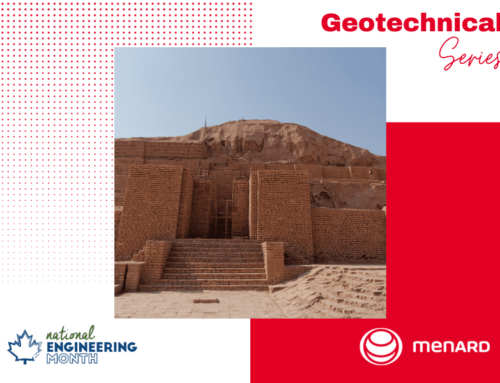
Faulty Designs: Lessons from the Failures of the Past
MENARD CANADA GEOTECHNICAL SERIES
Humans have constructed remarkable structures throughout history, many of which prove our engineering expertise. However, not all achievements in engineering have been successful. In the realm of geotechnical engineering, there have been instances where structures failed due to faulty design. These failures are invaluable lessons, providing insights into the complexities of soil mechanics, foundation engineering, and structural stability. By documenting and examining historic geotechnical failures, engineers gain a much deeper understanding of the challenges inherent in such projects and continue to refine their approaches to ensure the safety and longevity of future structures.
The Lesson of Failure
The history of geotechnical engineering is full of examples of structures that failed due to design flaws, very often with catastrophic consequences. While ancient civilizations achieved remarkable feats of construction and design, they also struggled with inherent risks and challenges. Ultimately, the lessons of the past serve as guideposts for us to build a safer, more resilient future.
One of the most iconic engineering disaster examples of antiquity is the collapse of the Colossus of Rhodes. Erected in the 3rd century BCE to commemorate the victory of the island of Rhodes over the ruler of Cyprus, this giant statue of the sun god Helios stood over 30 meters tall. Constructed using bronze plates over an iron framework, the Colossus was a marvel of ancient engineering. However, just 56 years after its completion, an earthquake struck Rhodes, causing the statue to collapse. While the exact cause of the collapse remains debated, it is believed that the structure’s slender legs could not withstand the seismic forces, leading to its downfall. Lesson Learned: The collapse of the Colossus highlights the importance of structural stability and resilience in engineering projects, particularly in seismically active regions.
In more recent history, the Leaning Tower of Pisa in Italy serves as a cautionary tale of the consequences of inadequate soil-baring capacity; this also generally goes for the construction of many structures before the 18th century. Construction of the tower began in 1173 A.D. when the Republic of Pisa was thriving and continued in various stages for well over 200 years. The tower weighs around 15,700 metric tons and is supported by a circular base with a diameter of 20 m. The tower has tilted in the past to the east, north, west, and finally, to the south. Recent investigations showed that a weak clay layer existed at a depth of about 11 m below the ground surface compression, which caused the tower to tilt. It became more than 5m out of plumb with the 54m height. The tower was even closed in 1990 because it was feared that it would either fall over or collapse. It recently has been stabilized by excavating soil from under the north side of the tower. About 70 metric tons of earth were removed in 41 separate extractions that spanned the width of the tower. As the ground gradually settled to fill the resulting space, the tilt of the tower eased. The tower now leans 5 degrees. The half-degree change is not noticeable to the naked eye, but it does, thankfully, make the structure considerably more stable.
Another more dramatic case is the collapse of the St. Francis Dam in California in 1928. Designed by William Mulholland, the dam failed due to poor foundation preparation and inadequate consideration of geological conditions. The tragedy claimed hundreds of lives and highlighted the importance of thorough site investigation and proper engineering analysis in geotechnical projects. Similarly, the failure of the Tacoma Narrows Bridge in 1940 underscored the significance of aerodynamics in structural design. The bridge’s innovative yet flawed design led to its dramatic collapse in high winds, prompting engineers to revisit their understanding of fluid-structure interactions and develop new design criteria to prevent such disasters.
Lessons Learned
These and other historic failures have yielded invaluable lessons for geotechnical engineers, helping to shape modern geotechnical practices and standards in the field. A Few Key takeaways from what we have learned from the past calamities include:
Comprehensive Site Investigation:
A thorough understanding of geological and geotechnical conditions is paramount in project planning. Site investigations should encompass soil testing, geological surveys, and geophysical assessments to identify potential hazards and inform design decisions.
Robust Design Methodologies:
Engineering design must account for a wide range of factors, including soil properties, structural dynamics, and environmental loads. Advanced analytical techniques, such as finite element analysis and computational modelling, help engineers simulate real-world conditions and optimize designs for safety and performance.
Risk Assessment and Mitigation:
Recognizing and mitigating potential risks is essential in geotechnical engineering. Engineers must conduct rigorous risk assessments, considering factors such as seismic activity, soil liquefaction, and climate change, and implement appropriate mitigation measures to enhance structural resilience.
Continuous Monitoring and Maintenance:
The longevity of geotechnical structures depends on ongoing monitoring and maintenance. Structural health monitoring systems enable engineers to detect early signs of deterioration or instability, allowing for timely interventions to prevent failures.
Interdisciplinary Collaboration:
Geotechnical engineering intersects with various disciplines, including geology, structural engineering, and environmental science. Collaborative approaches foster innovation and holistic problem-solving, ensuring that projects are resilient, sustainable, and cost-effective.
Looking Ahead
As society continues to push the boundaries of geotechnical engineering, the lessons learned from historic geotechnical failures continue to remain as relevant as ever. With more advances in technology and a deeper understanding of soil mechanics, geotechnical engineers are better equipped to tackle the challenges of the future. As we commemorate the lessons from failure, let us reiterate our commitment to excellence in geotechnical engineering and strive to build a safer and more resilient built environment for all. From resilient infrastructure to sustainable development, the principles of comprehensive engineering and lessons from past failures will help to guide the design and construction of geotechnical structures for generations to come.
Sources:
- Quizlet
https://quizlet.com/324263565/geotechnical-engineering-flash-cards/ - ResearchGate
https://www.researchgate.net/publication/288515983_Learning_from_Failures_A_Geotechnical_Perspective - WordPress.com
- https://benriya.wordpress.com/2008/10/22/geotechnical-engineering%E2%80%94-a-historical-perspective-i/#:~:text=About%2070%20metric%20tons%20of,tower%20now%20leans%205%20degrees.




